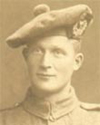In Memory ofALEXANDER PIRIEPrivate
|
|
Additional Information: Click on images to view details
|
Son of Alexander and Margaret Pirie, of Braefolds, Kennethmont, Aberdeenshire. Alexander Pirie and his wife Margaret Barron
are interred at Wallakirk Kirkyard, Glass. Alex Pirie Snr was from Glass and was farm grieve at Invermarkie Home Farm before becoming the tenant at Braefolds sometime after 1904. Alex Pirie was born in Glass and was the eldest son of Alexander Pirie and Margaret Barron. SDGW, He enlisted at Huntly and was killed in action, served France and Flanders. Only Alexander Pirie in 6GH served in "H"
Company, Book 6GH in F & F. 1914 Star, War & Victory Medals, France 10/11/1914, previously 10725 As a member of "H" Company 6GH (Territorial Batt) Alexander reported to Company HQ at Huntly following the order to mobilize on 4th August 1914 and proceeded to France with the battalion on 9th November. This qualified him for the 1914 or Mons Star in addition to the British War and Victory Medals. Alexander Pirie was killed in action during
the German Spring Offensive over the former Somme battlefields
of 21st-26th March 1918.
25/3/1918, 6GH in F & F 1/4/1908 The original Volunteer Battalions
was reorganised and the 4th became the 6th Batt ( Territorial
Force) comprising 8 companies centred in the following areas; Service notes 4/8/1914 at Keith: Gordon Brigade, Highland
Division. |
Commemorative Information
| Memorial: | ARRAS MEMORIAL, Pas de Calais, France |
| Grave
Reference/ Panel Number: |
Bay 8 and 9 |
|
Location:
|
The Arras Memorial is in the Faubourg-d'Amiens
Cemetery, which is in the Boulevard du General de Gaulle in the
western part of the town of Arras. The cemetery is near the Citadel,
approximately 2 kilometres due west of the railway station. The
Memorial commemorates almost 35,000 casualties of the British, New
Zealand and South African Forces who died between Spring 1916 and
7th August 1918, with the exception of casualties of the Battle
of Cambrai in 1917, and who have no known grave. The design, by
Sir Edward Lutyens, consists of a cloister, 25 feet high and 380
feet long, built up on Doric columns and faces west. In the broader
part of the site the colonnade returns to form a recessed and open
court, terminated by an apse. The names of the casualties are carved
on stone panels fixed to the cloister walls. |
| Historical Information: | The Memorial commemorates almost 35,000 casualties of the British, New Zealand and South African Forces who died between Spring 1916 and 7th August 1918, excluding casualties of the Battle of Cambrai in 1917, and who have no known grave. The design, by Sir Edward Lutyens, consists of a cloister built upon Doric columns and faces west. In the broader part of the site the colonnade returns to form a recessed and open court, terminated by an apse in front of which is the Arras Flying Services Memorial. The names of the casualties are carved on stone panels which are fixed to the cloister walls. |


